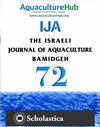The effects of alkalinity on production performance and biochemical responses of spiny lobster Panulirus homarus reared in recirculating aquaculture system
IF 0.5
4区 农林科学
Q4 FISHERIES
引用次数: 3
Abstract
Spiny lobsters (Panulirus sp.) were valuable and one of the most popular Indonesian export commodities. Some approaches were made to increase the quantity and quality of cultivated spiny lobsters. Land-based mariculture with Recirculating Aquaculture System (RAS) was applied to increase lobster harvesting and optimize environmental quality by adjusting water alkalinity. This study aimed to determine the optimum level of alkalinity for spiny lobsters Panulirus homarus rearing in RAS. This study investigated the effects of applying four water alkalinity levels (Control, 125, 200, and 275 mg L-1 CaCO3) on the biochemical responses of P. homarus observed in the hemolymph in terms of Total Hemocyte Count (THC), glucose, total protein, calcium, and pH levels. Furthermore, we also studied the alkalinity effects on lobster production performance parameters in terms of body weight gain, body length, Survival Rate (SR), Specific Growth Rate (SGR), and Feed Conversion Ratio (FCR). Lobsters with an initial weight rate of 58.05±1.69 g and an initial total length rate of 115.33±1.52 mm were reared for 60 days in a recirculation system. Results of water quality parameters such as ammonia, nitrite, nitrate, dissolved oxygen, temperature, and salinity during the study were available for lobster rearing. Different alkalinity levels affected the biochemical responses and production performance of lobsters. The best alkalinity level to reared Panulirus sp. in the recirculation system during this study was 200 mg L-1 CaCO3 so that it could achieve the highest survival rate of 86.67% with SGR 0.60±0.01 % day-1.碱度对循环水养殖小龙虾生产性能及生化反应的影响
带刺龙虾(Panulirus sp.)价值很高,是印尼最受欢迎的出口商品之一。提出了提高养殖龙虾数量和质量的措施。采用陆基循环水养殖系统(RAS),通过调节水体碱度,提高龙虾产量,优化环境质量。本研究的目的是确定在RAS环境下饲养大鲵的最佳碱度。本研究考察了四种水碱度水平(对照、125、200和275 mg L-1 CaCO3)对人弓形虫血淋巴中总血细胞计数(THC)、葡萄糖、总蛋白、钙和pH水平的生化反应的影响。此外,我们还研究了碱度对龙虾增重、体长、成活率(SR)、特定生长率(SGR)和饲料系数(FCR)等生产性能参数的影响。初始体重率为58.05±1.69 g,初始总长度率为115.33±1.52 mm,在循环系统中饲养60 d。研究期间的氨、亚硝酸盐、硝酸盐、溶解氧、温度、盐度等水质参数可用于龙虾养殖。不同碱度水平影响龙虾的生化反应和生产性能。本研究饲养的Panulirus sp.在循环系统中,最佳碱度为200 mg L-1 CaCO3,其最高存活率为86.67%,SGR为0.60±0.01% d -1。
本文章由计算机程序翻译,如有差异,请以英文原文为准。
求助全文
约1分钟内获得全文
求助全文
来源期刊
CiteScore
0.90
自引率
16.70%
发文量
49
审稿时长
3 months
期刊介绍:
Information not localized

 求助内容:
求助内容: 应助结果提醒方式:
应助结果提醒方式:


